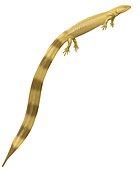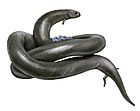Recumbirostra
| Recumbirostra Temporal range: Late Carboniferous - Early Permian,
| |
|---|---|

| |
| Life restoration of the ostodolepid Micraroter erythrogeios | |
| Scientific classification | |
| Kingdom: | Animalia |
| Phylum: | Chordata |
| Superclass: | Tetrapoda |
| Clade: | †Recumbirostra Anderson, 2007 |
| Subgroups | |
Recumbirostra is a clade of tetrapods which lived during the Carboniferous and Permian periods. It includes the families Pantylidae, Gymnarthridae, Ostodolepidae, Rhynchonkidae and Brachystelechidae, with additional families such as Microbrachidae and Molgophidae being included by some authors.[1][2] Recumbirostra was erected as a clade in 2007 to include many of the taxa traditionally grouped in "Microsauria", which has since been shown to be a paraphyletic or polyphyletic grouping.[3][4][5] Like other "microsaurs", the recumbirostrans have traditionally been considered to be members of the subclass Lepospondyli; however, phylogenetic analyses conducted by Pardo, Szostakiwskyj and Anderson (2015) and Pardo et al. (2017) recovered them as early-branching sauropsid amniotes instead.[6][3]
Not all phylogenetic analyses recognize Recumbirostra as a valid grouping. An alternative clade called Tuditanomorpha is occasionally supported and includes many of the same taxa.[7] Below is a cladogram showing the phylogenetic relationships of recumbirostrans from Glienke (2012):[1]
| Recumbirostra |
| ||||||||||||||||||||||||||||||||||||||||||||||||||||||||||||||||||||||||||||||||||||||||||||||||||||||
References[]
- ^ a b Glienke, S. (2012). "A new "microsaur" (Amphibia; Lepospondyli) from the Rotliegend of the Saar–Palatinate region (Carboniferous/Permian transition; West Germany)". Paläontologische Zeitschrift. 86 (3): 297–311. doi:10.1007/s12542-012-0130-8.
- ^ Mann, A.; Pardo, J. D.; Maddin, H. C. (2019). "Infernovenator steenae, a new serpentine recumbirostran from the 'Mazon Creek' Lagerstätte further clarifies lysorophian origins". Zoological Journal of the Linnean Society. 187 (2): 506–517. doi:10.1093/zoolinnean/zlz026.
- ^ a b Jason D. Pardo; Matt Szostakiwskyj; Per E. Ahlberg; Jason S. Anderson (2017). "Hidden morphological diversity among early tetrapods". Nature. 546 (7660): 642–645. Bibcode:2017Natur.546..642P. doi:10.1038/nature22966. hdl:1880/113382. PMID 28636600.
- ^ Anderson, J.S. (2007). "Incorporating ontogeny into the matrix: A phylogenetic evaluation of developmental evidence for the origin of modern Amphibians". In Anderson, J.S.; Sues, H.-D. (eds.). Major Transitions in Vertebrate Evolution. Bloomington and Indianapolis: Indiana University Press. pp. 182–227.
- ^ Huttenlocker, A. K.; Pardo, J. D.; Small, B. J.; Anderson, J. S. (2013). "Cranial morphology of recumbirostrans (Lepospondyli) from the Permian of Kansas and Nebraska, and early morphological evolution inferred by micro-computed tomography". Journal of Vertebrate Paleontology 33 (3): 540.
- ^ Jason D. Pardo, Matt Szostakiwskyj and Jason S. Anderson (2015). "Phylogenetic relationships of recumbirostran 'lepospondyls' inferred from neurocranial morphology". Society of Vertebrate Paleontology 75th Annual Meeting Program & Abstracts: 191.
- ^ Henrici, A.C.; Martens, T.; Berman, D.S.; Sumida, S.S. (2011). "An ostodolepid 'microsaur' (Lepospondyli) from the Lower Permian Tambach Formation of central Germany". Journal of Vertebrate Paleontology. 31 (5): 997–1004. doi:10.1080/02724634.2011.596601.
- Recumbirostrans
- Pennsylvanian first appearances
- Cisuralian extinctions
- Carboniferous animal stubs
- Permian animal stubs



